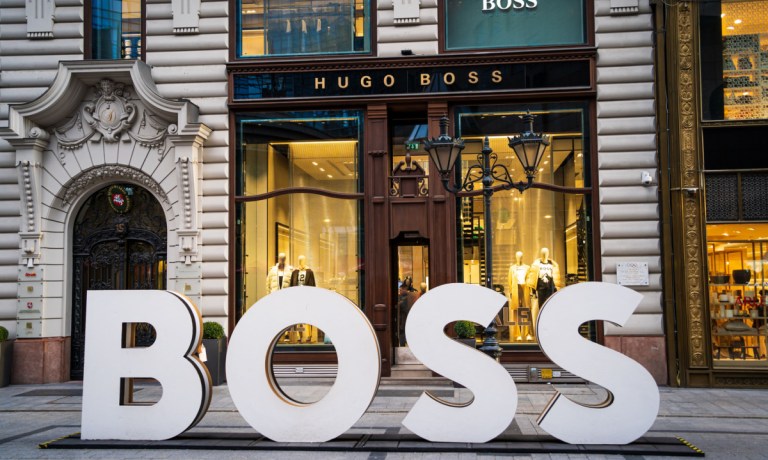Hugo Boss’ Digital Sales Up by 26% in Q4 as It Targets Gen Z and Millennials

Is it a case of normalization, inflation, or simply a need for brands and retailers to put in extra effort to connect with consumers, particularly those who could become lifelong customers?
PYMNTS explored this question amid the current slowdown in luxury retail. While labels like Burberry and retailers like Neiman Marcus are facing challenges, others like Brunello Cucinelli and Hugo Boss are experiencing a moment of pride.
See also: Brunello Cucinelli: When Consumers Recognize Product Value, They Spend
In fact, Hugo Boss managed to do better than expected in 2023, with an 18% increase in full-year sales ($4.57 billion).
“We ended 2023 on a high note, making it a record year for Hugo Boss,” CEO Daniel Grieder said in a Tuesday (Jan. 16) earnings press release. “The double-digit top and bottom-line improvements in the final quarter are all the more remarkable considering the current challenging global market environment.”
Under the Hood at Hugo Boss
After joining Hugo Boss in June 2021 from Tommy Hilfiger, Grieder has been spearheading a transformation at the company. He divided it into two brands: Boss targeting millennials and Hugo catering to Gen Z. His growth strategy, dubbed “Claim Five,” centers on strengthening brands, emphasizing product quality, taking a lead in the digital realm, finding balance in omnichannel approaches and organizing for growth.
The company emphasized the positive outcomes of its marketing, product, and distribution endeavors in Q4, leading to substantial momentum for both Boss and Hugo, with both brands achieving double-digit growth. Boss menswear sales increased by 13%, while both Boss womenswear and Hugo saw a growth of 14%.
Q4 also witnessed a 7% year-on-year growth in sales in EMEA, propelled by robust performance in Germany and France. The Americas sustained its growth with an 18% increase, and APAC saw a 33% increase, driven by improved sales in China and Southeast Asia.
Digital channel sales soared by 26% in Q4, propelled by revenues from both the Hugo Boss website and partners. Meanwhile, in physical stores, sales increased by 12% as productivity and selling space improved.
“With our strong brand momentum and the ongoing successful execution of our ‘Claim Five’ strategy, we have laid a robust foundation for continuing our market-share-winning trajectory and making further progress in becoming one of the top 100 global brands,” Grieder said.
That said, Hugo Boss is setting ambitious targets, aiming to achieve $5.43 billion in revenue by 2025, with an EBIT of at least $652.15 million.
The State of the Consumer
In 2023, the aspirational luxury consumer scaled back, leading some brands to focus on wealthier shoppers with available discretionary funds to spend.
As PYMNTS wrote last month, “Wealthy consumers are like the VIP shoppers of the economy, representing a select group but packing a punch in spending power that checks out as a disproportionate percentage of overall consumer expenditures. In fact, the wealthiest one-fifth of Americans account for about two-fifths of all spending.”
However, PYMNTS also documented that high-spending consumers, who heavily depend on credit cards for daily expenses, are now exploring alternative payment methods for essential goods and services.
Affirming this trend, a joint report from PYMNTS and Elan Credit Card discloses that over the last six months, one-third of cardholders raised their credit card spending, primarily due to an increase in costs. High spenders, making up 38% of consumers relying on credit cards for at least 40% of monthly expenses, encounter difficulties, with 12% carrying revolving balances. The reduction in wages and income, acknowledged by 22% of high spenders, adds to the heightened use of credit cards.
Read more: ‘High Spenders’ May Seek Credit Card Alternatives as Balances Build
Paying Attention to Gen Z
Hugo Boss has made an effort to reach Generation Z through its Hugo division, while simultaneously targeting millennials — the highest spenders on average, as per PYMNTS research — via its Boss division.
The National Retail Federation (NRF) show this week featured only one segment dedicated to Gen Z titled “Digital Strategies to Decode Gen Z,” but it doesn’t cover platforms like TikTok, Instagram or other social media channels where Gen Z is very active.
Read more: Millennials Turn to Deferred Payments to Spend More
By the Numbers
The German company has outperformed its sales goal of $4.35 billion for 2025, hitting this mark two years earlier than expected. Tuesday’s Hugo Boss earnings report showed the fourth quarter was the best in the company’s history in terms of sales, growing by 13% year on year to reach $1.28 billion.
In Q4, the earnings before interest and taxes (EBIT) increased by 17% to $131.52 million, slightly below the consensus. For the full year, EBIT rose 22%, reaching $445.64 million.